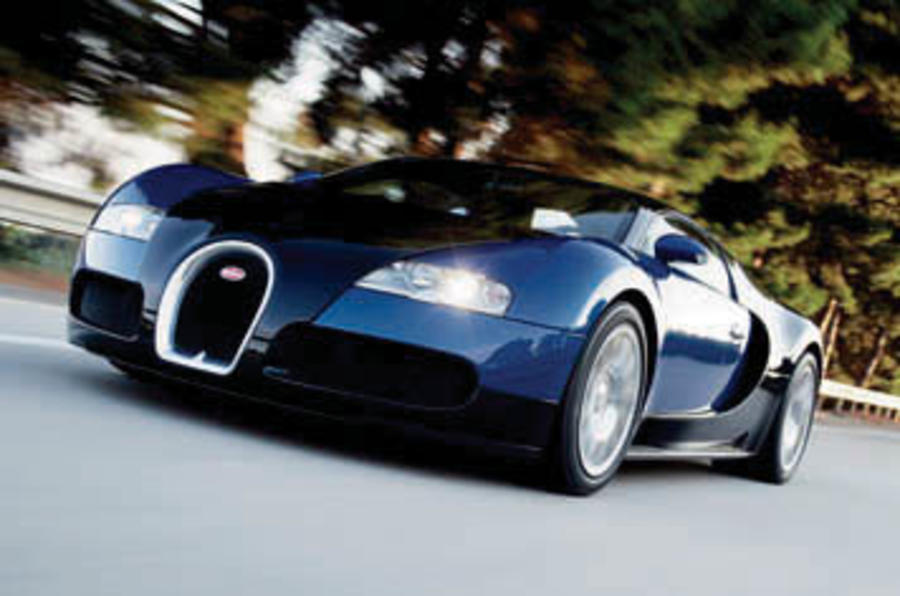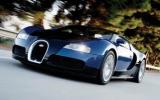So picture this. A long, long stretch of dual carriageway, two cars simmering beside each other at one end of it; a McLaren F1 plus a weird, insect-like machine with four huge tyres, an absurd number of scoops and winglets along the flanks and across the roof, plus a distinctive white-and-red badge on the nose that reads ‘Bugatti.’
On the tail are written the letters E and B. On top of the engine, which has no cover and is exposed directly to the air for cooling purposes, are the numbers 16 and four; 16 cylinders, four turbochargers. Which, in case you were wondering, equates to 987bhp and 922lb ft.
Out of nowhere the McLaren’s rear tyres suddenly light up and, after an eruption of V12 engine wail and wheelspin, it is gone, accelerating towards the far horizon. After 3.2sec it hits 60mph, after 6.3sec it reaches 100mph and after 10sec it passes 135mph. At which point the Bugatti sets off.
There is virtually no wheelspin whatsoever: the Veyron is four-wheel drive. What there is is noise – a peculiar kind of signature that sounds a bit like two TVR Griffiths on full reheat plus an industrial-strength air hose, all at once. And to accompany this cacophony there is mind-bending, heart-stopping acceleration the like of which has never been felt before in a road car.
After just 2.46sec the Veyron reaches 60mph, and barely a couple of seconds after that it bursts into three figures. But the thing you’ll really struggle to get your head round, the statistic you’ll be boring your mates with for some years to come, is this; despite setting off 10 seconds after the McLaren – when the F1 is already travelling at 130mph – the Bugatti reaches 200mph at exactly the same time as the F1. Think about that.
I have. And I still can’t quite fathom how rapid the Veyron must be to pull it off.
Actually, I can, because I’ve just driven it. For one full day around Sicily. And I can tell you it is sensational. Incredible. Unbelievable. Not merely the fastest and most powerful car the world has ever known but also, possibly, the best car ever.
And yet… I’m not 100 per cent sure it is the car I’d put in my all-time fantasy garage if literally it came down to a choice of just one. It should be, given that it costs £839,285 after tax, does 252mph and is technically the single most impressive car the world has ever seen.
But for curious reasons there’s also something clinical about the mighty Veyron that separates it from perfection, something almost too refined about its delivery that prevents it from wrenching on your heart strings in the manner that, say, a Ferrari F40 might or, whisper it, a Lamborghini Murciélago.
We’ll come to why a little later, but for the moment let’s savour the Veyron for what it is; undoubtedly the world’s most advanced car and certainly its fastest.
You’ll know by now that its birth was not an easy one, that it came to be because one day ex-VW boss Ferdinand Piech had a dream: to provide the world with a car that had 1000bhp, cost ¤1million and could do over 400km/h (250mph). To begin with the brief seemed impossible but in Piech’s mind, not something that couldn’t happen.























Join the debate
Add your comment
Re: Bugatti Veyron
Who keeps dragging these old threads up? This one is nearly 18 moths old for crying out loud.
Re: Bugatti Veyron
Aceman - I don't know where you live but in the Mayfair/Knightsbridge/Chelsea belt you see these on the street and for sale (if you want to see one there is one currently displayed at Jack Barclay's on Berkeley Square).
As to the question of who buys it anyway, London has plenty of people whose annual earnings are into 8 figures - these people buy these because they can, and owning such a machine comes with a certain amount of prestige in certain circles. I know of an owner now on his 3rd Veyron - also has the Koenigsegg, a Carrera GT etc. I think you'll find that above a certain level buyers do not so much worry about the price as the Veyron will be an iconic car in supercar history.
Re: Bugatti Veyron
when top gear put the Veyron around the top gear track everyone thought it would top the list, however as we all know it did not. Main reason its to heavy around the corners and on a track there are bends which the Veyron mass bulk and power struggle to cope with. to much power can corrupt the car